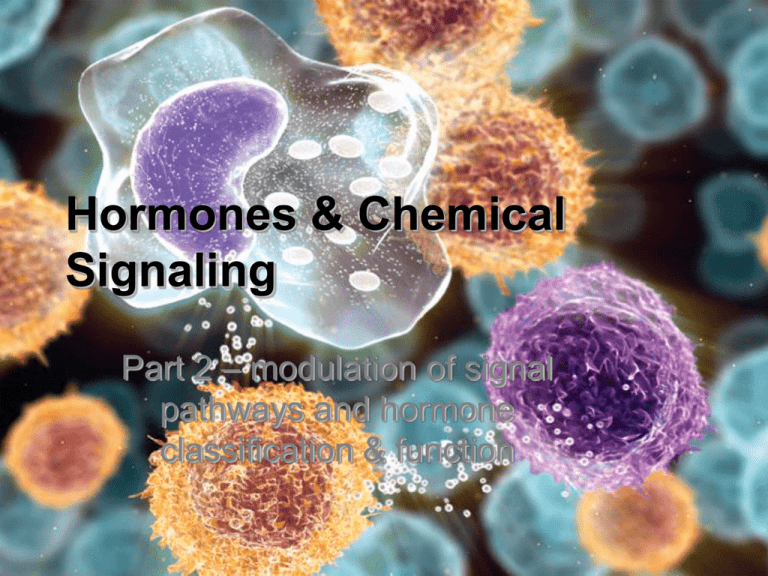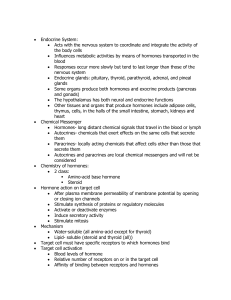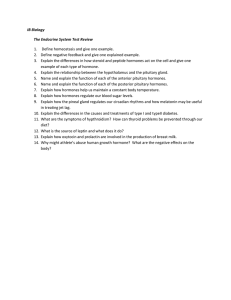Hormones & Chemical Messengers
advertisement

Hormones & Chemical Signaling Part 2 – modulation of signal pathways and hormone classification & function Communication Modulation of Signal Pathways • How are these pathways controlled? – Receptors are proteins! • Subject to – Specificity of binding – Competition for binding site » Agonists and antagonists – Saturation of ligand » Up regulation and down regulation of receptors – Pathways are mechanisms under homeostasis guidelines Communication Modulation of Signal Pathways • Specificity of Binding & Competition – Receptors have specific binding sites – Different compounds with similar molecular regions may bind to same site = competition – Ex. Epinephrine & norepinephrine have similar ligand structure and bind to a class of receptors called adrenergic receptors • Adrenergic receptors exhibit specificity • Adrenergic receptors are influence by competition Communication Modulation of Signal Pathways Communication Modulation of Signal Pathways • Advances in medicines – Due to study of active sites and their properties • Slightly changing the non-binding areas may change the duration of action progesterone progesterone binding area (green) progesterone agonists (used in birth control medications) Communication Modulation of Signal Pathways • Agonists vs. Antagonists – Agonists bind and cause activation – Antagonists bind and stop or prevent activation Communication: Deadly Effects • Muscarinic receptors – Bind acetylcholine (Ach) in the autonomic nervous system (ANS) – Also binds muscarine (a mushroom toxin) that • Mimics Ach (agonistic action) and can cause a severe parasympathomimetic to the point of death • Nicotinic receptors – Bind Ach at neuromuscular junctions – Also binds curare (poison arrow frog toxin) and blocks the receptor (antagonistic action) • Causes paralysis and very potentially death Communication Modulation of Signal Pathways • Up and Down-Regulation – Why? • To allow cells the ability to control the extent of signal pathway effect depending on – The concentration of signal in the ECF – The needs of the cell – Which form of diabetes would result in up and down regulation of insulin receptors? • Down-regulation vs desensitization – Down regulation is slower as cell needs to remove receptors from membrane – Desensitization is quicker as a binding agent can deactivate the receptor » For ex. adding a phosphate can deactivate a receptor (β adrenergic receptors) Communication Modulation of Signal Pathways • When the process has to stop – Enzymatic degradation of ligand – Removal of ligand by re-uptake – Endocytosis of receptor-ligand complex • Receptors can be reinserted into the membrane • Why do we care about this process? – Disease & Disorders Communication Modulation of Signal Pathways Communication Pathways • Controlled by homeostatic mechanisms regardless of type of pathway and resulting transduction of signal. • What are the options for getting the signal to the cell for transduction? Communication Pathways Communication Pathways • Similarities between neural and endocrine pathways? Communication Pathways • The homeostatic pathways are Communication Hormones • What are they? – Chemical messengers secreted by specialized cells • from isolated endocrine cells which makes up the diffuse endocrine system • from neurons • from immune system cells producing cytokines – Where do they go? • Into blood (most) • Into environment (ectohormones or pheromones) Communication Hormones – Involved in • • • • Growth Development Metabolism Reproduction – Act by 1. Altering rates of enzyme mediated reactions 2. Control the movement of molecules across the plasma membrane 3. Regulating the rate of gene expression (& therefore protein production) Communication Hormones • How do hormones get from point A to B? – To be classified as hormone & not a paracrine or autocrine hormone – Travel in blood • • • May require water soluble (protein) transport mechanism if hormone is lipid soluble Hormones act by binding to receptor on target cells Hormones have to have a mechanism for ending the effect – – – – Stop/reduce production of hormone Degrate hormones Enzymatic removal from receptor Endocytosis of receptor-hormone complex Communication Hormone Classification • Hormones are mainly classified by – Source – Structure Communication Hormone Classification • Hormones classified by source Communication Hormone Classification • Hormones classified by source Communication Hormone Classification • Hormones classified by structure – Peptide/protein hormones – Steroid hormones – Amino acid based hormones • Derived from tyrosine and may be – Catecholamines – Thyroid hormones Communication Hormone Classification • Peptide/protein hormones – Classification that includes most hormones – If a hormone is not a steroid hormone or an amino acid derived hormone, then it is a protein/peptide hormone! • Concerns with these hormones – – – – How they are made, stored and released How they are transported in blood The mechanism of action How long they last Communication Hormone Classification • Peptide/protein hormones & how they are made, stored and released Communication Hormone Classification (thyrotropin releasing hormone) has six copies of the 3-amino acid hormones TRH • PreproTSH Examples of hormone processing Prohormones may contain several peptide sequences that have biological activity The peptide chain of insulin’s prohormone folds back and is cleaved into insulin & C-peptide Communication Hormone Classification • Peptide/protein hormones – Cellular action mechanism • Lipophobic – must bind to receptors on membrane’s ECF surface • Most work via cAMP messenger system • Some via receptor-enzyme complexes – Enzyme attached and activated by binding is tyrosine kinase (recall these enzymes phosphorylate various substrates) » Insulin binds, tyrosine kinase activated and phosphorylates glucose to glucose 6-phosphate Communication Hormone Classification • Peptide/protein hormones – Duration • Depends on method of hormone action termination • Depends on molecule (some synthetic hormones have been modified to last longer) Communication Hormone Classification • Steroid Hormones – Lipophilic – creates problems • • • • No storage Production is on an “as needed” basis Can have the precursors in cytoplasm ready to go Require protein transports in blood – prolongs duration of hormone – Blocks entrance into cell… it must disengage from carrier this follows law of mass action… Communication Hormone Classification • Steroid hormones – Based on cholesterol – Produced using SER in the • Adrenal cortex • Gonads • Placenta – Secretion is by simple diffusion Communication Hormone Classification • Steroid Hormones – Cellular mechanism of action • Diffuses into cytosol and or into the nucleus • Acts as a transcription factors in the nucleus to alter gene activity by – Repressing or activating rates of transcription – Lag period due to the processes that have to occur • Transcription factors have DNA binding domains (DBDs) that tells them where to bind on the DNA (there are approx. 2000 known human transcription factors with specific DBDs • How are they regulated? – Negative feedback loop – increased transcription factors cause a decrease in production – Phosphorylation – may stop transcription – Ligand binding to transcription factors or cofactors that regulate the transcription factors… • New(er) research indicates that some steroid hormones have membrane receptors and signal transduction pathways similar in process to peptide/protein hormones – Nongenomic actions also attributed to aldosterone and estrogen Communication Hormone Classification • Steroid Hormone Action Communication Hormone Classification • Amino acid derived hormones may be – Derived from tyrosine – Produces • T3 & T4 • Epinephrine & norepinephrine Communication Hormone Classification • Amino acid derived hormones may be – Derived from tyrptophan – Produces • Melatonin • Serotonin* *serotonin is classified as a neurohormone as it is synthesized and secreted by neurons of the GI tract for regulation of motility and CNS Communication Hormone Controls • Hormones are controlled by reflex pathways most utilizing negative feedback loops! – May have multiple controls though









